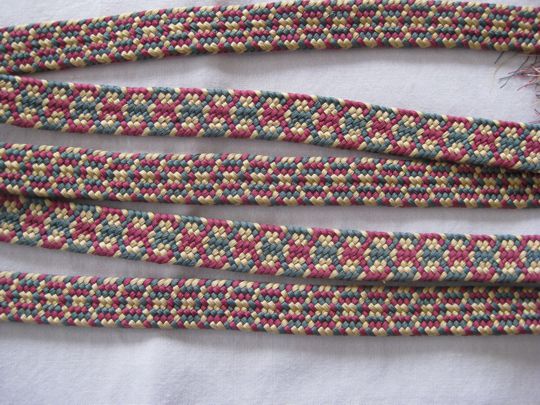
|

|
This cord is made of reeled silk braided in a kikko pattern. The braiding technique is called kumihimo in Japanese. Kumi meaning gather, and himo meaning string or cord. The specific pattern is a very old Japanese pattern called kikko or tortoise shell because hexagonal pattern formed by the contrasting colors resembles the hexagonal pattern on a tortoise shell. That pattern symbolizes long life. [1] The kikko braided pattern shown below dates to the Heian Period 794-1192 CE.
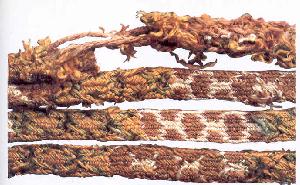
|
The first braid I made in this pattern was a proof-of-concept effort. It was only 2 feet long when finished and was braided with thin bundles of twisted silk yarn. I used the traditional two color pattern to show the kikko pattern [3]. This braid is my second effort. The goal was to braid a sageo cord, or cord that is used to attach the scabbard, or saya, of a japanese sword to the belt. In late medieval period and even today, a formal cord is braided with silk thread. Modern cords often between 70 and 86 inches long [4]. I chose to use pre-measured bundles of silk thread [5]. The bundles are 105" long. That is a common length used for braiding obi wrapping cords. Once braided the cord was about 62" long, excluding the end tassles. So this particular braiding pattern which uses 32 bundles of 42 threads each there is about a 40% take-up. If there were fewer threads of the same weight in each bundle, the take-up would be less, with more threads, the take-up would be more.
The the particular colors are to match a specific color of silk cord that will be used to wrap the hilt of a specific Japanese sword. The green is the same color as the hilt wrapping. The other colors are to blend in a Japanese color scheme and to match the colors of the sword. This particular three color pattern is a nice way to show off the kikko theme in the twined chain pattern that the green and burgundy silk form. The regular pattern also made is very easy to keep track of my place in the pattern.When braiding the goal is to keep the strands under even tension as you work. This keeps the material smooth in the finished pattern. To do this with a marudai, you wrap use weighted bobbins, or tama, to hold the bundles around the edge of the stand. The bundles meet in the middle and go down through the hole in the center where they attach to a weight bag. The weight bag has a counter weight that is about 40% of the combined weight of the bobbins. That counter weight provides the even tension. Usually, there is a leader cord of cotton or some other inexpensive fiber that you use to attach the braided material to the bobbin. It can add up to another yard of length to the bundle, and it allows you to braid up to the end of the pretty braided material, and still have the tama hang over the edge for tension.
The way that pre-cut silk bundles are prepared, gives you a twisted bundle of silk. The twist helps keep the threads from tangling. That means that you need to untwist the bundle before you wind it on the tama. To do this I tied all the bundles together at the top, the I put a knitting needle at the join to hold it in place. Next, for each bundle I stretched out the bundle and pulled along the length of silk to unwind and smooth the silk into an almost ribbon-like cord. Finally I attach the loose ends to the leader cord for the tama.
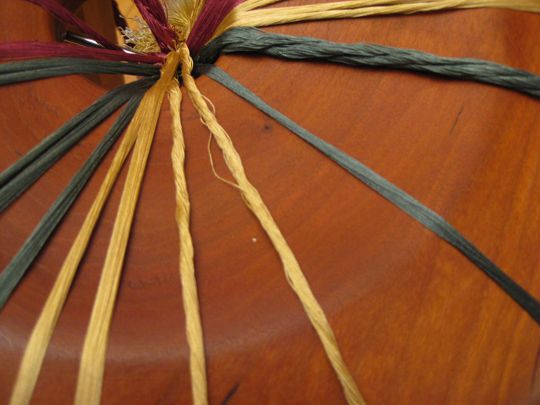
|
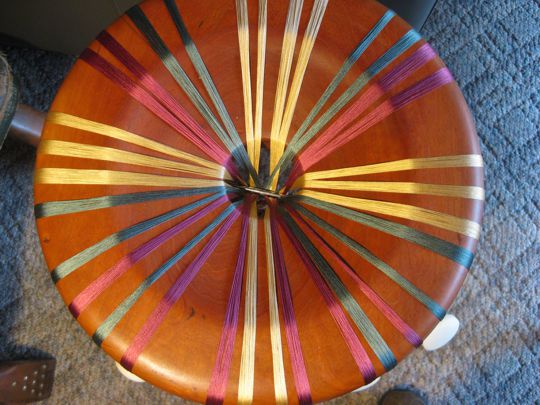
|
The strands start out smooth and flat. The goal when braiding is to maintain smooth and flat. I would check after eight moves that the strands were still flat, and if they were twisted, I would untwist. There is also the challenge to not snag or pull on the individual threads. If they got loose or uneven, I would unwind the bobbin a good length, smooth the threads and then rewind with even tension to smooth out the strand.
The other challenge when braiding is not to not mis-braid. Although there are 32 strands, the pattern is quite simple. There are only 8 moves done in sequence. The difficulty is that 32 bobbins is quite a lot to keep organized and to not pick up the wrong bundle or place it incorrectly. It is much more difficult to do this with 32 strands than with 16 or 8. To handle the volume, I would only run a sequence of 16 iterations of the 8 moves at a sitting. Because this particular color arrangement is symmetric vertically, the arrangement of the colors is back to original after 16 iterations instead of 32 for a non-symmetric pattern. That allowed me to check my work. Once I was more familiar with the color placements during the various stages, I could check my work more often. There were two other techniques I used to keep from mis-braiding. I had a chant that I would say to remind me what move comes next. By saying the chant as I braided, I was reminded of what to do next. The last technique I used was to always tidy up, or rearrange the threads, after each set of 8 moves.
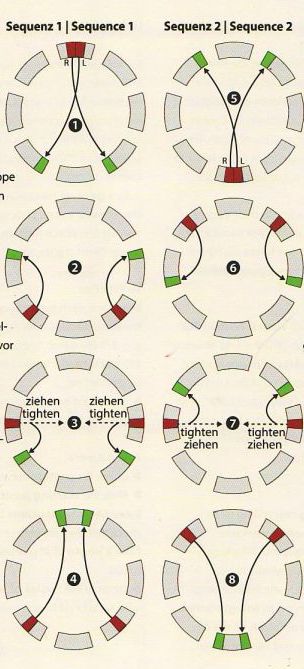
|
I finished the braid, then tied simple tassles at each end. Viola
As I said earlier this braid is intended be a sageo cord. That is the cord that a samurai uses to attach the sword scabbard to the belt. The cord is not very thin, often wider than 1/4", but it does need to fit through a knob, or kurikata, on the scabbard, or saya. Um... well... this braid too big to fit through that kurikata. I realized that as I was starting, but I did the braid anyway. Making the bundles smaller sounds simple, right? Well is isn't. To pull out a single strand, you can get the bundle somewhat tangled. If you pull multiple strands at the same time, even after untwisting, you end up with spagetti. I tried removing one strand at a time and as well as removing multiple strands after untwisting. If you want fewer strands in the bundle, either you buy it that way, or you make your own bundles.
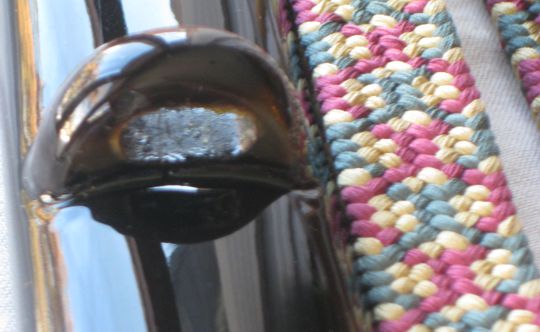
|
My next project is braiding a sageo cord in kikko braid pattern, but with the appropriate sized bundles of silk. There are sources for fine silk thread in a variety of colors [7], so I can make my own bundles. I will set up warping pegs and wrap the silk around the pegs in bundles of around 15-20 threads and tie them off. However, filament silk of single thickness that has been dyed, that is a better option still. The reason is that twisted 2ply silk is much more rigid than two individual single strands of silk. The sageo cord should be a little more than 1/4" wide, not very thick, and flexible. So dyed filament silk is ideal. It comes in skeins. The setup takes a bit longer. First I would need to wrap the silk onto cones or the tradition kiwaku, a large wooden spool. Then warp that silk as I previously described.
There is a book that was recently published by Claudia Wollny called "The Secrets of Kikko" [6]that show 85 distinct color arrangements for 32 strand kikko on the marudai. I used this book as my reference for how to do the braid, for picking the specific color setup that created this hexagonal chain pattern. The sequence of moves shown above is from that book.
[1] Carey, Jacqui. Samurai Undressed. Published by Carey Company, 1995.
[2] Japanese Kumihimo, the Art of Silk Braiding http://www.englisch.kumihimo.de/html/history.html Japanese Kumihimo, the Art of Silk Braiding
[3] Kikko Braid on the Marudeui http://www.sbooth.net/display-kikko-braid.html Kikko Braid on the Marudai
[4] Sword Buyer's Guide Sageo https://www.sword-buyers-guide.com/sageo.html Sword Buyer's Guide Sageo
[5] Pre-measured Premium Silk from BraidersHand https://braidershand.com/kumihimo-thread/reeled-silk-from-japan/premium-silk/ Pre-measured Premium Silk from BraidersHand
[6] Wollny, Claudia. The Secrets of Kikko. Claudia Wollny Edition, 2020. http://claudia-wollny-edition.com Wollny, Claudia. The Secrets of Kikko. Claudia Wollny Edition, 2020.
[7] Superior Threads Kimono Silk https://www.superiorthreads.com/thread/kimono-silk/c/60-189 Superior Threads Kimono Silk